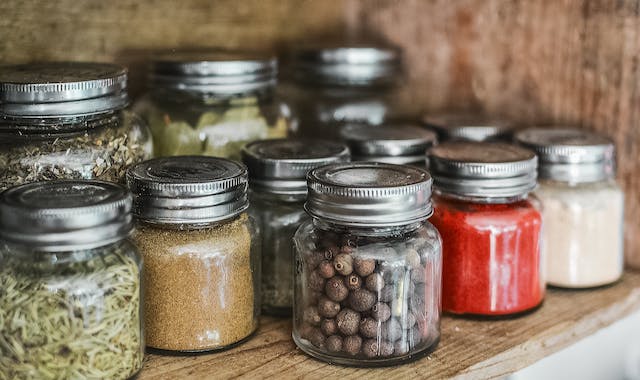
What is the difference between a herb and a spice? Herbs are the fresh part of the plant and spices are the dried root, stalk, seed, or fruit.
Herbs and spices have been used for thousands of years. People have used them to flavor food and as medicines. They are both different from vegetables because they are used in small amounts to flavor food and not as a source of food. Both words came into English from Latin. Herb comes from “herba”, which means grass, or green crops. Spice came from “species”, which means spices, goods, or wares.
Herbs and spices were used for their medicinal value before they were used in cooking. There is evidence that the Sumerians were using herbs and spices as medicine in 5000 BC, but it is likely that humans were using plants medicinally for thousands of years before there were even writing systems. Even animals are known to eat certain plants when they are sick and they presumably found this from trial and error. It is not a great stretch of the imagination to picture early humans doing it as well. China and India have been using herbs and spices as medicine since the beginnings of their civilizations. The Hippocratic medical system that we have in the west began with herbs and spices. We possibly frown on it today, but a lot of herbs and spices have proven medical benefits. Plants create hundreds of different chemicals to protect themselves from insects, fungi, diseases, or predators. These chemicals have different effects on humans depending on the quantities they are given in. This has been known for millennia and the Egyptians listed hundreds of medicinal herbs and spices in 3000 BC. Modern pharmaceutical companies still base some of their research into new drugs on the chemicals plants produce.
The first usage of herbs and spices for cooking probably came about when hunter gatherers wrapped meat in different types of leaves. They may have added berries and herbs and slowly come up with things that made the food last longer and taste better. They probably searched for the herbs that they liked to go with their meal, but they didn’t start cultivating them until the beginnings of agriculture. Different herbs were domesticated at different times. Coriander (cilantro) was domesticated in the Eastern Mediterranean 11,000 years ago. Garlic and basil 5,000 years ago. Cumin, black pepper, and cinnamon about 4,000 years ago.
So, what is the difference between herbs and spices? Herbs are the leafy part of the plant, and they are eaten fresh. Each type of herb has a strong and distinct flavor. The flavors are actually produced by the plant’s defense mechanism. All plants have evolved a defense against specific types of insects and predators. They do this through producing metabolites that are toxic to the creature they are trying to fend off. It just turns out that we find some of those toxins delicious. We have also greatly altered the taste and the toxicity of the original herbs. Through agricultural selection, we have slowly selected for herbs that have greater flavors and selected out the ones that do us harm.
Spices are the dried root, stalk, seed, or fruit of the plant. The flavor in the spice comes from exactly the same reason as the flavor in the herbs. The plants produce compounds to defend themselves against insects and predators. The difference between spices and herbs is that spices are dried and quite often ground into a powder as well. Drying allows the spices to be used for longer than herbs can be. Also, the compounds that the plant uses for defense are inside an oil and when the spice is ground, it increases the surface area of the spice, bringing the oil into contact with oxygen, and it becomes volatile. When this happens and the spice is cooked in a dish, the volatile compounds change shape and connect with other compounds to make complex flavors and aromas.
There are some plants that are used as herbs and spices. Coriander (cilantro) is a good example. The leaves are used as a herb and the seeds are ground up to use as a spice. There are many other examples as well.
Herbs and spices have anti-bacterial properties and there is some argument that countries with warm climates tend to use more herbs and spices than countries with cooler climates. The argument is that the food has a greater chance of spoiling in a warm climate and the herbs and spices will protect the person eating it from food poisoning. Some people argue that the anti-bacterial properties aren’t strong enough to make a difference and countries with a hot climate use more herbs and spices simply to cover up the taste of the food that has gone bad. And this is what I learned today.
Photo by Pixabay: https://www.pexels.com/photo/aroma-aromatic-assortment-bottles-531446/
Sources
https://www.seriouseats.com/toast-grind-whole-spices-for-more-flavor
https://www.utsc.utoronto.ca/~burton/foodcourse/spices.html
https://theconversation.com/how-do-spices-get-their-flavor-202591
https://hortnews.extension.iastate.edu/faq/what-difference-between-herb-and-spice
https://www.almanac.com/what-difference-between-spices-and-herbs
https://www.britannica.com/story/whats-the-difference-between-an-herb-and-a-spice
https://tastybite.com/blogs/news/herbs-vs-spices-do-you-know-the-difference
https://www.eupedia.com/history/timeline_of_plant_and_animal_domestication.shtml
